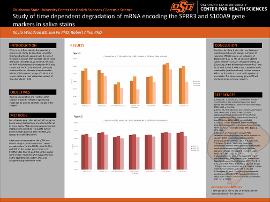| dc.contributor.author | Woodson, Kayla | |
| dc.contributor.author | Fu, Jun | |
| dc.contributor.author | Allen, Robert | |
| dc.date.accessioned | 2023-09-12T16:45:19Z | |
| dc.date.available | 2023-09-12T16:45:19Z | |
| dc.date.issued | 2022-02-18 | |
| dc.identifier | ouhd_Woodson_studyoftimedependentdegradation_2022 | |
| dc.identifier.citation | Woodson, K., Fu, J., & Allen, R. (2022, February 18). Study of time dependent degradation of mRNA encoding the SPRR3 and S100A9 gene markers in saliva stains. Poster presented at Research Days at Oklahoma State University Center for Health Sciences, Tulsa, Ok. | |
| dc.identifier.uri | https://hdl.handle.net/11244/339562 | |
| dc.description.abstract | When a body fluid stain is found at a crime scene, it may be beneficial to use the RNA found within to approximate the age of the stain. This is important in cases where a person of interest has been known to be in a location several times before any crime occurred. RNA has proven to be useful in the field of forensic investigation; however, it has been shown to be less stable than DNA. The analysis of mRNA includes common methods like reverse transcription PCR, or RT-PCR. Research has previously been conducted in this laboratory has shown the relationship between the age of a blood stain and semen stain and the amount of RNA degradation. In this experiment, buccal swabs were collected and placed in a box to dry in a room temperature environment. Swabs were left to dry for time intervals of up to one month, after which mRNA was extracted and reverse transcribed to cDNA. Transcripts for the saliva specific marker SPRR3, along with S100A9, typically expressed in the esophagus, were analyzed through real time qPCR analysis. Results so far show that as the time between sample acquisition and analysis increases, Ct values increase for the marker SPRR3, which shows the transcripts are undergoing degradation. Ct values for the S100A9 marker appears to stay relatively constant. These results can be helpful in real world case work where a saliva sample may have been left out accidentally, but can still be used to produce mRNA. By studying the effects of time on mRNA degradation, the age of a stain can be approximated. | |
| dc.format | application/pdf | |
| dc.language | en_US | |
| dc.publisher | Oklahoma State University Center for Health Sciences | |
| dc.rights | The author(s) retain the copyright or have the right to deposit the item giving the Oklahoma State University Library a limited, non-exclusive right to share this material in its institutional repository. Contact Digital Resources and Discovery Services at lib-dls@okstate.edu or 405-744-9161 for the permission policy on the use, reproduction or distribution of this material. | |
| dc.title | Study of time dependent degradation of mRNA encoding the SPRR3 and S100A9 gene markers in saliva stains | |
| osu.filename | ouhd_Woodson_studyoftimedependentdegradation_2022.pdf | |
| dc.type.genre | Presentation | |
| dc.type.material | Text | |
| dc.subject.keywords | mRNA degradation | |
| dc.subject.keywords | saliva stains | |
| dc.subject.keywords | qPCR analysis | |
